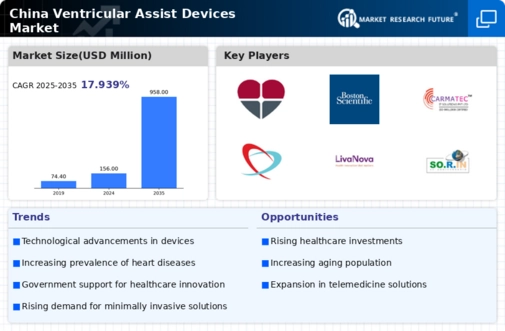Increasing Aging Population
The aging population in China is a crucial driver for the ventricular assist-devices market. As life expectancy rises, the prevalence of age-related cardiovascular diseases increases, leading to a higher demand for advanced medical devices. In 2025, it is estimated that over 20% of the Chinese population will be aged 60 and above, creating a significant market for ventricular assist devices. This demographic shift necessitates innovative solutions to manage heart failure and other cardiovascular conditions, thereby propelling the growth of the ventricular assist-devices market. Furthermore, the healthcare system is adapting to cater to this demographic, which may lead to increased funding and resources allocated to cardiac care, further enhancing the market landscape.
Rising Healthcare Expenditure
China's rising healthcare expenditure is a pivotal factor influencing the ventricular assist-devices market. The government has been increasing its investment in healthcare infrastructure, aiming to improve access to advanced medical technologies. In recent years, healthcare spending has grown at an annual rate of approximately 10%, indicating a strong commitment to enhancing medical services. This financial support is likely to facilitate the adoption of ventricular assist devices, as hospitals and healthcare providers seek to incorporate cutting-edge technologies into their treatment protocols. Additionally, increased funding for research and development in cardiac care may lead to innovative solutions, further driving the growth of the ventricular assist-devices market.
Growing Awareness of Heart Health
The growing awareness of heart health among the Chinese population is significantly impacting the ventricular assist-devices market. Public health campaigns and educational initiatives have led to increased knowledge about cardiovascular diseases and the importance of early intervention. As a result, more individuals are seeking medical advice and treatment options for heart-related issues. This heightened awareness is likely to drive demand for ventricular assist devices, as patients and healthcare providers recognize the benefits of these technologies in managing severe heart conditions. Furthermore, the emphasis on preventive care may lead to earlier diagnoses, increasing the potential market for ventricular assist devices in the coming years.
Supportive Regulatory Environment
A supportive regulatory environment in China is fostering the growth of the ventricular assist-devices market. The government has implemented streamlined approval processes for medical devices, encouraging innovation and expediting the introduction of new technologies. Regulatory bodies are increasingly recognizing the importance of ventricular assist devices in treating heart failure, leading to more favorable policies and guidelines. This supportive framework not only facilitates market entry for new products but also enhances the overall competitiveness of the ventricular assist-devices market. As manufacturers navigate the regulatory landscape more efficiently, they are likely to invest in research and development, further propelling market growth.
Technological Innovations in Medical Devices
Technological innovations in medical devices are transforming the landscape of the ventricular assist-devices market. Advances in materials science, miniaturization, and battery technology are enabling the development of more efficient and patient-friendly devices. For instance, the introduction of wireless monitoring systems and biocompatible materials enhances the functionality and safety of ventricular assist devices. These innovations not only improve patient outcomes but also attract investment from both public and private sectors. As the demand for advanced cardiac care solutions continues to rise, the ventricular assist-devices market is likely to benefit from ongoing technological advancements, which may lead to increased adoption rates and market growth.

















Leave a Comment